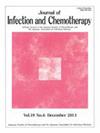First reported case of disseminated Cunninghamella phaeospora infection with multidrug resistance in acute myeloid leukemia
IF 1.9
4区 医学
Q3 INFECTIOUS DISEASES
引用次数: 0
Abstract
Mucormycosis is a severe mold infection primarily affecting immunocompromised patients. Neutropenia, steroid use, hyperglycemia, and diabetes are recognized as significant risk factors. Cunninghamella species are rare pathogenic fungi associated with high mortality rates and multidrug resistance. However, there have been no reports of C. phaeospora being identified as the causative agent of clinical infection. We report a case of a 71-year-old man who developed right middle lobe pneumonia during salvage induction therapy for relapsed acute myeloid leukemia. Based on the clinical course, mucormycosis was suspected, and antifungal therapy was initiated with isavuconazole (200 mg every 8 hours for six doses, followed by 200 mg daily) and later switched to liposomal amphotericin B (5 mg/kg/day). Despite these interventions, the patient's respiratory failure progressed, culminating in a fatal hemorrhagic infarction of the right lung. An autopsy revealed invasive fungal involvement in multiple organs, including the lungs and liver. Genetic identification of the isolated fungi demonstrated C. phaeospora, confirming disseminated C. phaeospora infection. Susceptibility testing showed high Minimum Inhibition Concentrations/Minimum Effective Concentrations to all tested antifungal agents. This is the first reported case of disseminated infection caused by C. phaeospora with multidrug resistance. This case highlights the diagnostic and therapeutic challenges associated with rare pathogenic fungi. It underscores the importance of early identification of Mucorales, including susceptibility testing, to optimize antifungal therapy and consider appropriate surgical interventions. Further research is required to elucidate the mechanisms of antifungal resistance and clinical characteristics of C. phaeospora.
急性髓系白血病播散性多药耐药康宁哈默氏菌感染首例报道。
毛霉病是一种严重的霉菌感染,主要影响免疫功能低下的患者。中性粒细胞减少、类固醇使用、高血糖和糖尿病被认为是重要的危险因素。坎宁哈默氏菌是一种罕见的致病性真菌,具有高致死率和多药耐药性。然而,目前还没有关于红孢梭菌被确定为临床感染的病原体的报道。我们报告一例71岁的男性在抢救诱导治疗复发性急性髓性白血病期间发生右中叶肺炎。根据临床病程,怀疑为毛霉病,开始使用异戊康唑(每8小时200毫克,共6次,随后每天200毫克)进行抗真菌治疗,后来改用两性霉素B脂质体(5毫克/公斤/天)。尽管采取了这些干预措施,患者的呼吸衰竭仍在恶化,最终导致致命的右肺出血性梗死。尸检显示真菌侵入了包括肺和肝在内的多个器官。对分离真菌进行遗传鉴定,证实该真菌具有弥散性phaeospora感染。药敏试验表明,所有抗真菌药物均具有较高的最低抑制浓度/最低有效浓度。这是首例报道的由多药耐药的褐孢梭菌引起的播散性感染病例。该病例突出了与罕见致病真菌相关的诊断和治疗挑战。它强调了早期识别毛霉菌的重要性,包括药敏试验,以优化抗真菌治疗和考虑适当的手术干预。phaeospora的抗真菌耐药机制和临床特点有待进一步研究。
本文章由计算机程序翻译,如有差异,请以英文原文为准。
求助全文
约1分钟内获得全文
求助全文
来源期刊

Journal of Infection and Chemotherapy
INFECTIOUS DISEASES-PHARMACOLOGY & PHARMACY
CiteScore
4.10
自引率
4.50%
发文量
303
审稿时长
47 days
期刊介绍:
The Journal of Infection and Chemotherapy (JIC) — official journal of the Japanese Society of Chemotherapy and The Japanese Association for Infectious Diseases — welcomes original papers, laboratory or clinical, as well as case reports, notes, committee reports, surveillance and guidelines from all parts of the world on all aspects of chemotherapy, covering the pathogenesis, diagnosis, treatment, and control of infection, including treatment with anticancer drugs. Experimental studies on animal models and pharmacokinetics, and reports on epidemiology and clinical trials are particularly welcome.
 求助内容:
求助内容: 应助结果提醒方式:
应助结果提醒方式:


